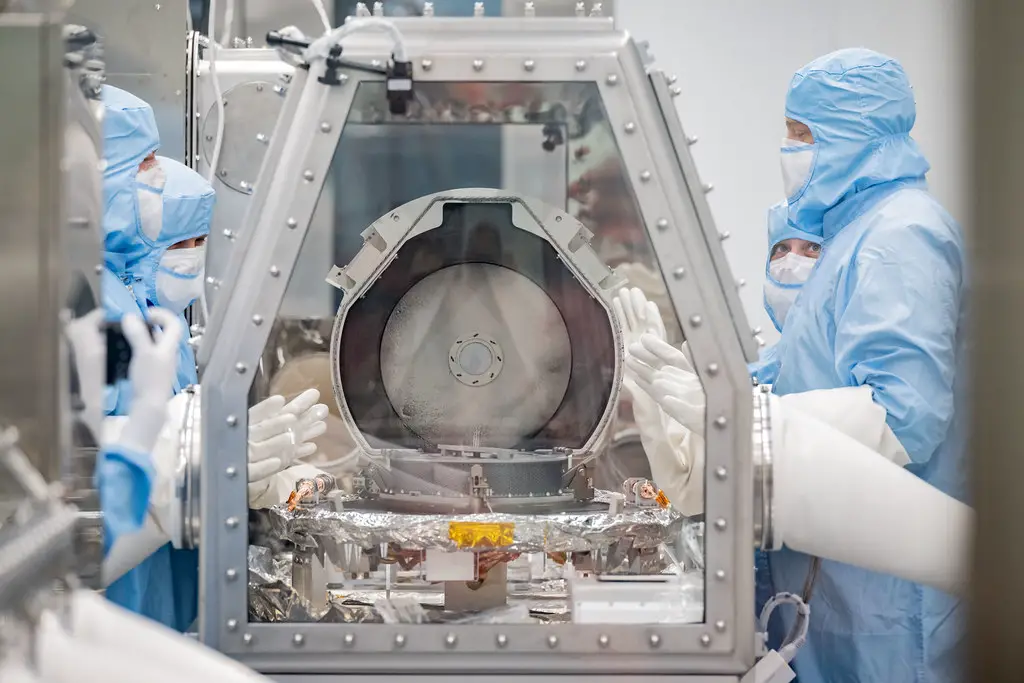After overcoming the difficulty of jammed fasteners and successfully extracting the final fragment of its valuable asteroid sample, NASA’s innovative project OSIRIS-REx has accomplished a significant milestone. With careful collection from the ancient asteroid Bennu, this sample has enormous potential for scientific discoveries that could solve our universe’s secrets. With this breakthrough, scientists and researchers are now excitedly anticipating the chance to examine this incredible sample in greater detail in the hopes of revealing amazing new information about the birth of our solar system and the origins of life itself.
The OSIRIS-REx Mission
The remarkable goal of the U.S. mission known as OSIRIS-REx, which stands for Origins, Spectral Interpretation, Resource Identification, Security, and Regolith Explorer, is to retrieve an asteroid sample from Bennu and return it to Earth for in-depth analysis. This ground-breaking spacecraft set off on an incredible voyage to the near-Earth asteroid Bennu, which is situated roughly 200 million miles from Earth. OSIRIS-REx approached Bennu with great success, using state-of-the-art technology and exact precision to scan its surface and locate possible sampling locations. The spacecraft used its novel Touch-And-Go Sample Acquisition Mechanism (TAGSAM) to gather a pure sample of regolith, or surface material, from Bennu’s rough topography after carefully analyzing the data. The spacecraft then descended towards the asteroid. This incredible accomplishment demonstrated humanity’s capacity to reach out and touch far-off celestial bodies and was a critical turning point in the history of space travel.
Through a thorough examination of the samples brought back from Bennu, scientists intend to solve the riddles surrounding the early genesis of our solar system and obtain priceless knowledge regarding the beginnings of life on Earth. The meticulously maintained and sealed samples of obtained regolith could provide unique insights into the composition, structure, and history of Bennu and our cosmic vicinity. Researchers will examine the samples using cutting-edge laboratory analyses and sophisticated imaging techniques, looking for organic compounds, minerals that contain water, and other essential components that may provide insight into the processes that led to the formation of planets and the emergence of life.
On September 24, 2023, OSIRIS-REx triumphantly returned to Earth after an incredible multi-year journey, carrying with it not just samples of the asteroid but also a plethora of knowledge and ground-breaking discoveries. In order to uncover the mysteries concealed inside these priceless extraterrestrial materials, scientists and specialists from a variety of fields will work together in specialized laboratories to do the thorough study of the collected samples. It is anticipated that the results of this remarkable expedition will completely rewrite our knowledge of asteroids, the early solar system, and our role in the universe, creating new study opportunities and stimulating ambitious plans for space travel in the future.
Unlocking the Sample
The NASA curation team, consisting of highly competent and experienced individuals, carried out an extensive and meticulous process to unlock the sample. Due to the stuck screws that had initially impeded access, they handled the sample with the utmost care, guaranteeing its integrity and taking further safeguards.
The group’s commitment and tenacity were evident as they painstakingly battled to overcome this obstacle. They worked the equipment with such deft precision, using just enough force to pry the sample from its intransigent confines. A collective sigh of relief flooded the room as the last fastening loosened with a pleasant click.
The sample has now been released, allowing the team to go on to the next phase of the operation. This is the start of an exciting new chapter in which a thorough study will reveal the secrets buried within the sample. Every granule and particle has the capacity to reveal a wealth of fresh information and discoveries, stoking the scientific curiosity that propels research. The group’s work has opened the door to ground-breaking findings that will influence how we perceive the cosmos and beyond.
A Wealth of Information
A preliminary study of the Bennu asteroid sample has produced some interesting results. It has been found that this sample includes a considerable amount of water in addition to being rich in carbon. Since carbon is the primary component of organic molecules, which are essential to life as we know it, its quantity is very significant. Water is also an essential component in the hunt for possible habitats that might support life beyond Earth, which gives this discovery an additional level of relevance.
The fact that the sample taken from Bennu is the biggest carbon-rich asteroid sample ever sent to Earth adds even more significance to this discovery. Researchers are now keen to examine this sample in further depth in the hopes of learning more about our solar system and solving puzzles regarding the beginnings of life. Researchers hope to learn more about the early phases of the construction of our solar system and possibly even solve the age-old existential mystery of the origins of life by analyzing the components from Bennu. These recent discoveries have the potential to shed light on a plethora of fresh information and broaden our comprehension of the universe.
What’s Next?
Now that the sample is available, the study may proceed. Global scientists will examine the materials in an effort to learn more about the past and perhaps even the future of our universe. The accomplishment of this mission is a victory not only for NASA but also for humanity’s endeavor to comprehend its position in the universe.
Once again, the OSIRIS-REx mission has shown the value of technological innovation and scientific investigation. The unsealed Bennu asteroid sample is proof positive of human curiosity and the never-ending search for knowledge.
Sources
![]()
